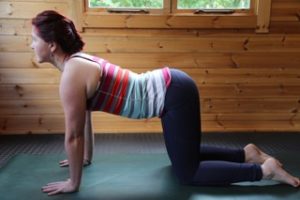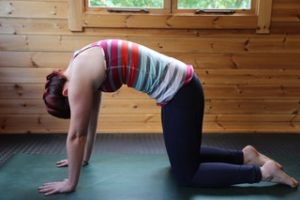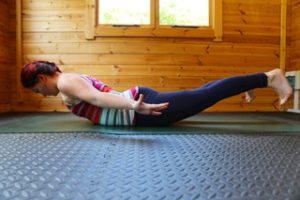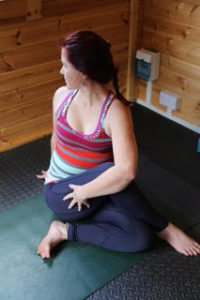Three Easy Yoga Poses for Spinal Health
Regardless of your role within the veterinary profession, the chances are at some point you will put your back in a compromising position experiencing either short-term or more serious aches and pains as a result. Whether it’s bending over an immobile consulting/dental table, restraining and lifting patients, sitting at a desk for multiple hours a day, or driving around in your car after wrestling animals that weigh a lot more than you do, our roles demand a lot from us in different ways both physically and mentally.
If you’ve ever suffered with a back injury, you’ll know the real impact that acute/chronic pain and reduction in spinal mobility can have on your health and wellbeing, and you also wouldn’t be alone. According to the NHS website, “back pain is the largest single cause of disability in the UK, with lower back pain alone accounting for 11% of the total disability of the UK population”[1], and while more research is needed specifically for the vet profession, one study [2] showed a significant prevalence of strains, sprains, back injuries and other repetitive motion injuries reported by veterinary colleagues.
Show your spine some self-care
The good news is that there are plenty of things you can do to support your own spinal health, including strengthening and releasing tension from the supporting musculature, working with the natural curvature of your spine, and improving flexibility to maintain your full range of spinal mobility. Yoga is a fantastic practice for looking after your spine – as well as coming with a whole host of physical, mental and emotional health benefits – and has been found to be more effective for helping with chronic lower back pain than other forms of aerobic exercise and a self-help book [3]
As someone who suffered with a lower back injury in my early twenties, and who continues to work in practice alongside teaching yoga, here are 3 of my favourite yoga poses that I recommend for keeping veterinary backs bending instead of breaking! (It goes without saying that if you have an active back injury, are pregnant, or have any health concerns, get the go-ahead for yoga from your doctor/healthcare professionals before giving these a try).
Cat-Cow (Marjaryasana – Bitilasana)
Great for spinal mobility, flowing through even just a few rounds of Cat-Cow a day can help you to release tension and ease any tight spots along your back. The act of matching your movement to your breath is also very soothing for your nervous system, helping you to unwind and relax.


For a full step-by-step guide of this pose see: https://vetyogi.com/blog-details/cat-cow-animal-yoga-pose-series
Locust Pose (Shalabhasana)
Combining strengthening with lengthening, Locust is another great full-body option. The variations that this pose offers makes it ideal for beginners and more experienced yogis alike, as you can match the level of pose to your level of fitness and intensity. Those needing to work on building strength can try just lifting the legs, or lifting an opposite arm/leg and then swapping, and those wanting to work a bit harder can lift all 4 limbs together, and even try reaching arms overhead.

For a full step-by-step guide of this pose see: https://vetyogi.com/blog-details/locust-animal-yoga-pose-series
Lord of the Fishes Pose (Ardha Matsyendrasana)
Rotational movement is an essential part of maintaining good spinal health, so adding in some gentle twists to your daily routine or yoga practice is beneficial. This pose not only helps with flexibility of the spine, but also helps you to stretch into the outer hip, so is great if you are short on time or energy as you get a lot out of one pose.

For a full step-by-step guide of this pose see: https://vetyogi.com/blog-details/lord-of-the-fishes-animal-yoga-pose-series
Remember that a little yoga goes a long way especially when done on a regular basis, so if you are really struggling for time or energy, any time spent on your mat will be better than none, even just a few minutes! If you fancy putting these poses and more into practice, there are multiple free yoga videos suitable for all levels available via the VetYogi YouTube channel: https://vetyogi.com/videos, with some of them being just 5 mins long.
By Chloe, VetYogi
References
[1] https://www.england.nhs.uk/blog/charles-greenough/
[2] Occupational health hazards in veterinary medicine: Physical, psychological, and chemical hazards. Tasha Epp, Cheryl Waldner. Can Vet J 2012;53:151–157
[3] Comparing Yoga, Exercise, and a Self-care Book for Chronic Low Back Pain. Sherman, Cherkin, Erro, et al. 2005.
Dr. Chloe Hannigan BVetMed MRCVS (RYT-500), Founder and Director, VetYogi Ltd
Chloe is a locum small animal vet and registered Yoga Alliance Professionals yoga/meditation teacher, and founded VetYogi in 2017 to improve the physical, mental and emotional wellbeing of the veterinary profession. Through VetYogi Chloe provides tailored yoga and meditation classes, workshops and conference speaker sessions for veterinary individuals, practices and groups. She is passionate about providing wellness tools for the whole veterinary team, and teaches various styles of yoga, including Hatha, Vinyasa, Yin and Yoga Nidra. VetYogi also offers a selection of yoga props, clothing and accessories, and VY home fragrance gifts all designed to help busy working professionals create a sanctuary of calm in their own space. For more information see www.vetyogi.com

